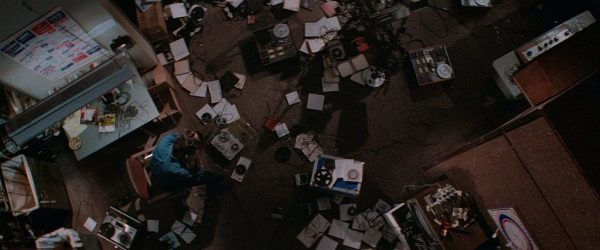Blow Out (1981)
- Soames Inscker

- May 29
- 4 min read
Updated: Jun 8

Brian De Palma’s Blow Out (1981) is a gripping political thriller that doubles as an intricate meditation on perception, media manipulation, and the existential weight of truth. Both an homage to Michelangelo Antonioni’s Blow-Up (1966) and Francis Ford Coppola’s The Conversation (1974), Blow Out finds its own voice through De Palma’s signature stylistic bravado, razor-sharp editing, and a surprisingly powerful performance by John Travolta.
Released in the aftermath of Watergate and the Vietnam War, Blow Out reflects a deep cynicism toward institutions and a growing sense of American disillusionment. Though it underperformed at the box office, it has since gained cult status and is now considered one of De Palma’s masterpieces—and one of the best political thrillers of the 1980s.
Plot Summary
Jack Terry (John Travolta) is a sound effects technician for low-budget horror films. While recording ambient sounds for a project, he accidentally records what seems to be a car accident. The vehicle plunges into a river, and Jack saves a young woman, Sally (Nancy Allen), from the wreck. The man who dies is revealed to be a presidential hopeful, Governor McRyan.
As Jack reviews his audio tape, he becomes convinced the crash was not an accident but an assassination—a gunshot precedes the tire blowout. He sets out to uncover the truth, dragging Sally into his obsessive quest. But as he delves deeper, Jack finds himself caught in a deadly conspiracy involving a psychopathic operative (John Lithgow in a chilling role) and a government eager to cover up the truth.
Themes and Analysis
Truth and Perception
At the heart of Blow Out lies an exploration of truth in a world ruled by deception. Jack’s profession—manipulating sound for fake horror films—ironically contrasts with his struggle to reveal an authentic, horrific truth. His recordings offer a kind of evidence that, in De Palma's world, can be distorted, ignored, or rendered meaningless by those in power.
The film also delves into the act of filmmaking itself. Jack’s montage of sound and image to reconstruct the accident mirrors the role of the director or journalist assembling a narrative—but the result, no matter how truthful, may never be believed. The irony is biting: Jack creates an undeniable piece of "evidence," but it costs lives and ultimately changes nothing.
Political Paranoia and the Post-Watergate Hangover

Blow Out is steeped in 1970s-style political paranoia, even though it arrived in the early Reagan era. It echoes the national mood of betrayal and cynicism, showing how systems of justice and power are more interested in self-preservation than uncovering the truth.
De Palma links this to American myth-making. The idea of a lone individual (Jack) fighting against a conspiracy recalls classic noir, but in this story, the knight doesn’t win. The ending is not just tragic—it’s devastating, reinforcing the futility of one man's fight against a corrupt machine.
Performances
John Travolta delivers arguably the best dramatic performance of his early career. Coming off his late-'70s fame with Saturday Night Fever and Grease, Travolta shows surprising depth as Jack Terry, a man tortured by a past mistake and determined not to let history repeat itself. His growing obsession and ultimate helplessness are portrayed with subtle vulnerability.
Nancy Allen is sympathetic as Sally, a seemingly naive character who reveals unexpected strength and warmth. Her chemistry with Travolta is genuine, which makes the film’s climax all the more harrowing.
John Lithgow is terrifying as Burke, a freelance operative whose patriotism turns into psychosis. He is one of De Palma’s most effective villains—calm, methodical, and chillingly unfeeling.
Dennis Franz, as a sleazy photographer, provides a dash of dark comic relief while contributing to the film’s gallery of morally compromised figures.
Direction and Style

Brian De Palma’s visual style is on full display here. The film features elaborate split screens, overhead tracking shots, long takes, and virtuoso editing. One standout sequence is the use of split diopter lenses during scenes of surveillance or dual perception, emphasizing the divided reality Jack is up against.
The sequence at the Liberty Day parade, with Jack racing through crowds trying to stop the inevitable, is a tour de force—editing, music, and image colliding in a chaotic crescendo. The fireworks punctuating the climax provide bitter irony: a celebration of liberty amid the silencing of truth.
Pino Donaggio’s haunting score adds emotional weight, blending romance, suspense, and pathos. The final use of sound—a scream—is among the most gut-wrenching endings in cinema, undercutting the artificiality of horror with raw, human tragedy.
Legacy and Critical Reappraisal
Initially dismissed by some critics and overlooked by audiences, Blow Out has since been reassessed and is now often ranked among De Palma’s finest works. It was championed by Quentin Tarantino (who named it one of his favorite films), and has influenced countless filmmakers. It also serves as a time capsule—technologically (reel-to-reel tapes, film editing by hand) and politically.
De Palma’s earlier work was often accused of being derivative or overly indebted to Hitchcock, but Blow Out proved that he could synthesize his influences into a deeply personal and politically resonant statement. It remains a high point of 1980s American cinema.
Conclusion
Blow Out is more than a stylish thriller—it’s a bleak, beautifully crafted elegy for truth in the postmodern world. With its tragic ending and powerful commentary on media, manipulation, and the cost of knowing too much, the film earns its place as a classic.
It is a movie that doesn’t just entertain; it disturbs, lingers, and forces us to question the narratives we're told—and the ones we tell ourselves.
A masterclass in cinematic paranoia and one of the most intelligent political thrillers ever made.






